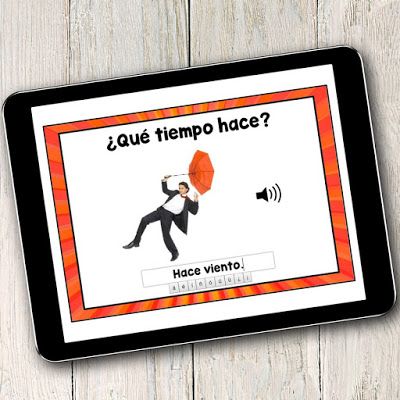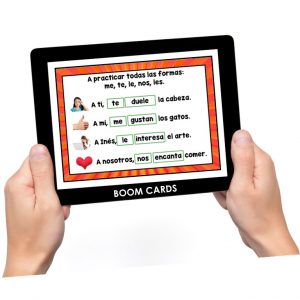Are your students still making their own Spanish flashcards?
I sure hope not! Here are the problems with student-made Spanish flashcards.
- They don’t have visual cues.
- Students spell the words wrong.
- English on the cards prevents true immersion.
- Students lose their flashcards.
- Students don’t even bother to make them in the first place.
Check out 3 new types of flashcards that are so much more effective!
In this post, I’ll discuss the different types of Spanish flashcards, how to use them in class, and I’ll link to free sets for each type of flashcard so you can test them out and see which ones you like the best.
Grab them all at once in my World Language Cafe Free Resource Library or click on the individual links in this post.
INTERACTIVE NOTEBOOK FLASHCARDS
TRIFOLD STORY SPANISH FLASHCARDS
These are another type of interactive notebook flashcard, but each flashcard strip tells a short story. The students read the sentences and write the vocabulary word 3 times into the story on one side. Then they flip the flashcard over and fill in more of the blanks of the same story on the other side. Finally, they write the whole story underneath the flashcard in their notebooks.
Great for sneaking in grammar when they’re not expecting it. By the time they’re done, they have written each vocab word or verb 9 times in context. Get a free set for AR verbs or fruits.
ONLINE DIGITAL FLASHCARDS
Quizlet, Memrize, GimKit, Boom Cards . . . So many different options for students who like to practice online!
My favorite platform is Boom Learning because the flashcards have sound files and drag and drop features. The sound files are great because students can hear the actual pronunciation of the word.
What I also like about Boom is that students focus on learning instead of just playing games or freezing out other students. They have fun doing GimKit, but they don’t learn very much. And with Quizlet and Memrize, they can’t hear how the word is pronounced.
The cards are self-correcting and if you buy FastPass, ~$25 for the year, (well worth it in my opinion), you get results in real time that show how each student is doing.
So if you notice that Billy is really struggling, you can help him or if you notice that the whole class is having trouble, you should spend more time on that particular concept.
You can also just get a free basic account – it only takes 1-2 minutes to set up. All you have to do is send your students the link to the deck of cards and your work is done. Pretty sweet!
Be sure to get your free set of digital clothing flashcards.
So which type of Spanish flashcard is right for your students?
My answer is why do you have to pick just one?
Keep things fresh in your classroom and use a variety of flashcards throughout the year – see which ones your students like best.
Or give your students choices and options. From time to time, let them pick whether to complete an assignment with trifolds, regular INB’s, or digital flashcards. Differentiated learning at its best!
Remember to get your free sets of flashcards in the Free Resource Library or by clicking on the individual links above. I’d love to know which type you like the best in the comments section!






















2 Comments
How do you work with words that can’t be defined with a picture. Like months of the year or adjectives (colorful, smooth, articles…. ) ?
Good question! Those are definitely more tricky. I try to teach them in the context of sentences, TPRS style. Ex. Is the rock smooth or rough? Is the desk soon though or rough? and ask progressively harder things, trying to present the word as many times as possible. You can hold up examples of items. Ex. Colorful pictures vs black and white. Another option is to look up the gesture in sign language and teach them that. When you say the word, they do the sign. And finally, with really tricky words, play hot/cold with one hard word. Someone hides an object and another person looks for it. As they get closer, the class says the tricky word louder and faster.